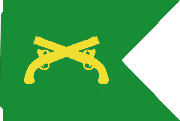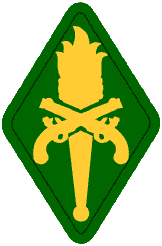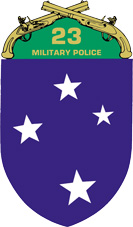
The insignia of crossed pistols for the Military Police Corps was approved in 1923. The insignia is not crossed dueling pistols as many people believe. The device is a scale model of the Harpers Ferry Army officers' sidearm and holster pistol of a century and a half ago.
The original pistols, for the design were in the collection of Major Jerome Clark, U.S. Army. The device and its development were the idea of Captain George M. Chandler, War Department General Staff, U.S. Army. The drawings for the insignia were made in 1922 by the Heraldic Section, Quartermaster General.
In 1920, when a reorganization of the Army occurred, the original staff study assigned 5000 infantrymen to the military police mission. Chief of Infantry, Major General Farnsworth, protested this arrangement because it charged him with troops that he would never have under his control. He won his point with the general staff, and the War Department created another temporary arm of the service--The Corps of Military Police. A new corps insignia was needed, and a new collar mark had to be devised.
The infantryman carried a musket, the cavalryman wore a saber, and the military policeman carried a billy-club. The draftsman was instructed to draw crossed billy-clubs. The result was a failure. At saluting distance the MP could not be distinguished from the field artilleryman. The club insignia looked like crossed cannon.
Next the medieval military club, the mace, was tried. Beautiful drawings were made but looked like crossed potato mashers. The MP was armed with a .45 caliber automatic pistol. This was tried as an insignia but looked like carpenter's squares. The .45 caliber pistol, like the others, made inartistic devices.
The heraldic section was reminded of the Harpers Ferry Army Arsenal flintlock pistol. Everyone interested in the new insignia agreed, and the Chief of Staff, General Pershing, signed the drawings and later approved the metal collar mark which is now worn by the Army Military Police.
 There are a few theories as to how the Military Police Corps acquired the colors of green and yellow.
1. The uniform coats of the enlisted dragoons during the American Revolution were green with black trim and yellow buttons and button holes.
2. In World War I, the military police of the American Expeditionary Force in France wore a yellow and green cord on their hats.
3. The MP Corps has the same lineage as the Cavalry, both having originated with the Dragoons, thus the yellow of the Cavalry was retained. The green was taken from the staff of the Provost Marshal Branch.
In any case, in 1921 the colors of green and yellow were officially adopted for the Army Military Police with green on the field of yellow. In 1941 the colors were reversed with yellow on green.
There are a few theories as to how the Military Police Corps acquired the colors of green and yellow.
1. The uniform coats of the enlisted dragoons during the American Revolution were green with black trim and yellow buttons and button holes.
2. In World War I, the military police of the American Expeditionary Force in France wore a yellow and green cord on their hats.
3. The MP Corps has the same lineage as the Cavalry, both having originated with the Dragoons, thus the yellow of the Cavalry was retained. The green was taken from the staff of the Provost Marshal Branch.
In any case, in 1921 the colors of green and yellow were officially adopted for the Army Military Police with green on the field of yellow. In 1941 the colors were reversed with yellow on green.
 MP School Patch Description:
MP School Patch Description:United States Army Military Police School (USAMPS) U.S. ARMY MILITARY POLICE SCHOOL SHOULDER SLEEVE INSIGNIA Shoulder Sleeve Insignia. Description: On a green lozenge 2 inches (5.08cm) in width and 3 inches (7.62cm) in height overall, with rounded corners, a yellow torch surmounted by crossed yellow pistols. Symbolism: The crossed pistols are taken from the Military Police Corps branch insignia. The torch signifies knowledge and enlightenment. Background: The shoulder sleeve insignia was originally approved for the Provost Marshal General Center on 17 Jun 1960. It was redesignated for the Provost Marshal General's School on 23 Oct 1962. On 21 Jul 1965 the insignia was redesignated for the U.S. Army Military Police School.
 Constituted 3 Apri1 1943 in the Army of the United States as the Military Po1ice P1atoon America1 Division
Activated 1 May 1943 in New Ca1edon1a
Inactivated 2 December 1945 at Fort Lawton, Washington
Redesignated 1 December 1954 as the 23d Military Po1ice Company and allotted to the Regu1ar Army (America1 Division redesignated 1 December 1954 as the 23d Infantry Division).
Activated 2 December 1954 at Fort Amador. Canal Zone
Inactivated 10 April 1956 at Fort Amador. Cana1 Zone Activated 8 December 1967 in Vietnam
Inactivated 28 June 1972
Activated 21 October 2005 Ft Bragg NC.
Constituted 3 Apri1 1943 in the Army of the United States as the Military Po1ice P1atoon America1 Division
Activated 1 May 1943 in New Ca1edon1a
Inactivated 2 December 1945 at Fort Lawton, Washington
Redesignated 1 December 1954 as the 23d Military Po1ice Company and allotted to the Regu1ar Army (America1 Division redesignated 1 December 1954 as the 23d Infantry Division).
Activated 2 December 1954 at Fort Amador. Canal Zone
Inactivated 10 April 1956 at Fort Amador. Cana1 Zone Activated 8 December 1967 in Vietnam
Inactivated 28 June 1972
Activated 21 October 2005 Ft Bragg NC.
| CAMPAIGN PARTICIPATION CREDIT |
World War II -AP |
| Northern Solomons |
| Leyte |
| Southern Philippines (with arrowhead) |
Vietnam |
| Counteroffensive, Phase III |
| Tet Counteroffensive |
| Counteroffensive, Phase IV |
| Counteroffensive, Phase VI |
| Tet 69/Counteroffensive |
| Summer-Fall 1969 |
| Winter-Spring 1970 |
| Sanctuary Counteroffensive |
| Counteroffensive. Phase VI |
| Conso1idat1on I |
| Conso1idat1on II |
